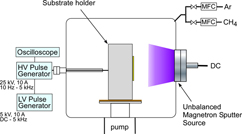Article contents
Properties of hydrogenated DLC films as prepared by a combined method of plasma source ion implantation and unbalanced magnetron sputtering
Published online by Cambridge University Press: 31 October 2011
Abstract

Unbalanced magnetron sputtering (UBMS) is suitable for the preparation of hard and hydrogen-free diamond-like carbon (DLC) films. Since those films generally suffer from internal stresses and bad adhesion, the addition of a methane source offers two advantages: (i) the control of the film properties by variation of the hydrogen content and (ii) a pretreatment of methane plasma source ion implantation (PSII), which results in a gradient carbon layer within the substrates, ensuring the adhesion of the subsequently deposited DLC films. PSII and UBMS were combined to prepare DLC films on stainless steel substrates and silicon wafers. Different amounts of methane were added to the working gas, argon, to investigate the effect of the hydrogen content on the film properties, i.e., hardness, adhesion, and friction coefficient. Composition and chemical structure of the films were investigated by depth profiling (secondary-ion mass spectrometry) and Raman spectroscopy. Smooth adhesive films could be obtained with the lowest friction coefficient for small additions of methane as a hydrogen source during the sputtering process.
Keywords
Information
- Type
- Articles
- Information
- Journal of Materials Research , Volume 27 , Issue 5: Focus Issue: Plasma and Ion-Beam Assisted Materials Processing , 14 March 2012 , pp. 845 - 849
- Copyright
- Copyright © Materials Research Society 2011
References
REFERENCES
- 11
- Cited by

